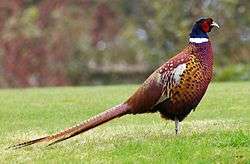Phasianus
| Phasianus Temporal range: miocene-Recent, 5.4–0 Ma | |
|---|---|
 | |
| Mongolian ringneck-type common pheasant (P. colchicus) cock | |
| Scientific classification | |
| Kingdom: | Animalia |
| Phylum: | Chordata |
| Class: | Aves |
| Order: | Galliformes |
| Family: | Phasianidae |
| Subfamily: | Phasianinae |
| Genus: | Phasianus Linnaeus, 1758 |
| Type species | |
| Phasianus colchicus Linnaeus, 1758 | |
| Species | |
|
One or two, see text | |
The "typical" pheasant genus Phasianus in the family Phasianidae consists of at least one species. The genus name comes from Latin phasianinus "pheasant-like" (from phasianus, "pheasant").[1] Both Phasianus and "pheasant" originally come from the Greek word phāsiānos, meaning "(bird) of the Phasis".[2] Phasis is the ancient name of the main river of western Georgia, currently called the Rioni.
The common pheasant (P. colchicus) has about thirty recognised subspecies forming 5 or 6 distinct groups; one is only found on the island of Taiwan off the southern coast of continental China, and the rest on the Asian mainland, reaching west to the Caucasus. Some subspecies have been introduced to Europe, North America and elsewhere, where they have hybridized and become well established.
The three subspecies on the Japanese islands are usually treated as a distinct species, the green pheasant (P. versicolor), but some consider the Japanese birds to be part of the common pheasant complex, making thirty-three subspecies in total.
Fossil remains of a Phasianus pheasant have been found in Late Miocene rocks in China. Thus, like many other phasianid genera this lineage dates back more than 5 million years.
References
- ↑ Jobling, James A (2010). The Helm Dictionary of Scientific Bird Names. London: Christopher Helm. p. 302. ISBN 978-1-4081-2501-4.
- ↑ Online Etymology Dictionary